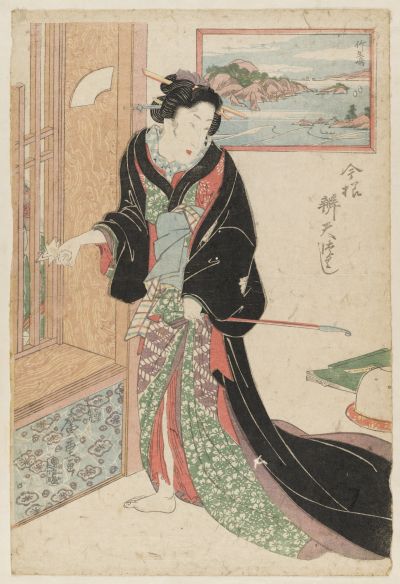
A rare early print by one of the masters of ukiyo-e (the great period of Japanese prints), an enigmatic glimpse at life behind the shutters of the yoshiwara (Red Light District), showing a courtesan secretly passing money to a street-musician.
The print on the wall behind her shows an island with a shrine to the goddess Benzaiten, and links this picture to a famous Noh play called Chikubushima – as the print is also named – suggesting that the courtesan and the musician are not necessarily what they appear to be, but could be avatars of Benzaiten and the Dragon King of the Sea, transposed to the yoshiwara.
Hiroshige was one of the most important ukiyo-e artists of the nineteenth century. He is best known for his landscapes, which were a significant influence on Van Gogh, and his lively views of Edo (now Tokyo), showing the sights of the city and people going about their everyday lives. However, in the early part of his career, up until about 1830, his prints were of more conventional subjects, of actors, warriors and beautiful women. This is a very early print, made when he was still in his 20s.
It is one of a series of bijin-ga entitled The Summation of the Modern Benten. Benten, or Benzaiten, is the only goddess among the Seven Lucky Gods, goddess of luck, eloquence and music.
In this print, a courtesan in a richly-patterned kimono, holding a long kiseru pipe, is in her room in one of the brothels of the yoshiwara, with a print of the island of Chikubushima on the wall. Outside, half-hidden by the heavy wooden shutters, is a street musician, and she is secretly slipping him some money wrapped in a piece of paper.
This enigmatic image appears to relate to a Noh play in which a courtier visits the famous shrine of Benten on Chikubushima in Lake Biwa. He is taken across in a boat by a mysterious old fisherman and a beautiful young woman. When he gets to the island, they tell him about the shrine and he realises that they aren’t human. They then reveal themselves to be the Dragon King of the Sea and the goddess Benten herself. the print links to the story, suggesting that the musician might be seen as the Dragon King in disguise, whilst the courtesan is the form taken by the goddess in the city of Edo.
This is a rare and important print in Worcester City’s collection by one of the great stars of Japanese print-making.